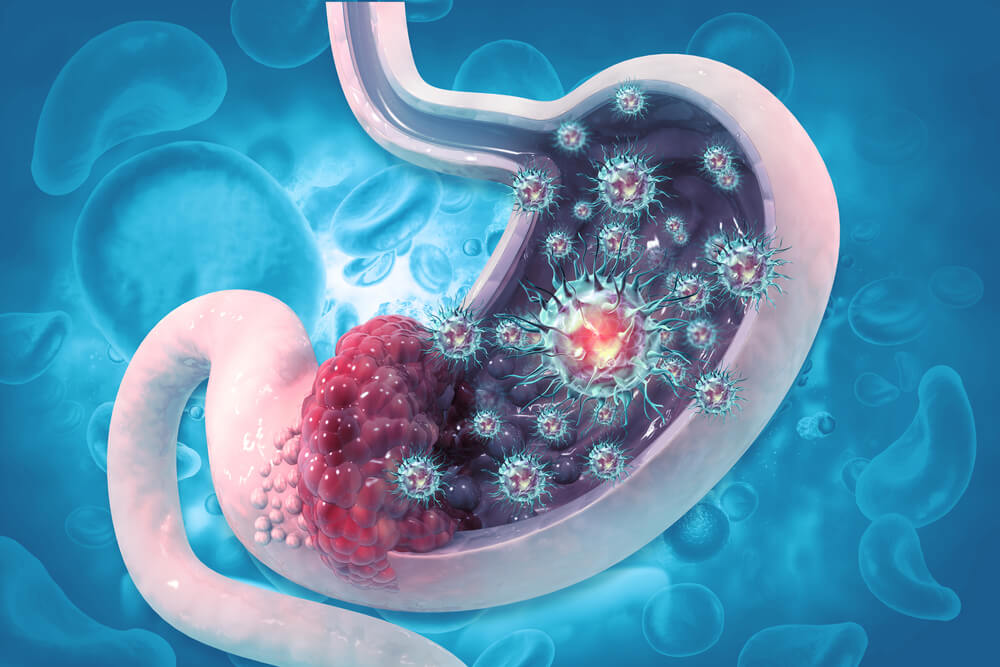Stomach cancer is a relatively common malignancy, with statistics showing that around 7 in 100,000 people get a diagnosis each year.
The disease primarily affects older patients, but it’s equally prevalent among genders, with men usually being more susceptible to developing the problem.
Because detecting stomach cancer symptoms can prove difficult, patients and health experts should understand the unique signs and traits this malignancy can mimic.
As such, in this article, we’ll aim to cover the most obvious signs, talk about when to worry about stomach cancer, and discuss different stomach cancer stages, along with stomach cancer treatment options.
When to Worry About Stomach Cancer – What is It?
Gastric, or stomach cancer, is a disease in which healthy and normal cells are suddenly replaced by rapidly growing and dividing cancer cells inside the lining of the stomach. The stomach is the organ directly under the esophagus, the tube that allows the food to get into the intestines after biting, chewing, and swallowing.
When cancer develops, the malignant cells start to grow and divide uncontrollably, replacing healthy cells. As cancer progresses, it can spread and even move to neighboring organs or even further in the body, attacking other healthy organs.
Pinpointing stomach cancer symptoms can often be difficult because the malignancy usually grows slowly, which can take years to develop. On the other hand, this can be somewhat beneficial during gastric cancer staging, especially when the malignancy is discovered early.

Types of Gastric Cancer
Based on the location where the cancer cells start to grow, experts differentiate several gastric malignancy types:
- Adenocarcinoma: This disease develops in the stomach’s innermost lining. This is also the most common variant of gastric cancer, which occurs in roughly about 90% of cases after assessing the presence of stomach cancer symptoms.
- Lymphoma: This is actually a malignancy of the immune system and accounts for only about 4% of all gastric cancers. It can be broken up into two subsets:
- Primary lymphoma: Initially involving the stomach, the disease may spread to the lymph nodes, the bone marrow, and other organs.
- Secondary lymphoma: This initially originates from other areas of the body, like the bone marrow, lymph nodes, or circulating blood. The stomach cancer symptoms show secondarily as the malignancy spreads to the stomach.
- Gastrointestinal Stromal Tumor: This is a soft tissue sarcoma that can develop in the connective tissue of the stomach.
- Neuroendocrine cancer: These cancer cells originally come from the endocrine and nervous systems of the intestine. They are also referred to as carcinoid tumors.
Stomach Cancer Stages
Gastric cancer staging will most probably be staged on the spread and the severity of the cell growth. In the case of adenocarcinoma, or malignancies that form in the glandular tissue in different organ linings, staging is usually based on the TNM system, or the tumor, node, metastasis method.
As such, TNM staging looks like this:
- The T stands for how deeply has the cancerous tumor spread into the wall of the stomach
- The N stands for whether cancer has managed to spread to the lymphatic system
- The M stands for whether the disease has managed to spread to other organs
Experts can perform gastric cancer staging based on the information gathered following the TNM staging.
Stomach cancer staging may have the following levels:
- Stage 0 is the malignancy at its early stage, on the lining of the stomach, on the surface.
- Stage 1A or 1B
- Stage 2A or stage 2B, in which cancer has managed to spread deeper in the wall of the stomach
- Stages 3A, 3B, and 3C, in which the lymph nodes are usually also infected
- Stage 4, in which the malignancy has spread to other organs as well.
Gastric Cancer Causes
Unfortunately, medical experts can’t rule out a single main cause for these malignancies, and in some cases, they may develop without any risk factors.
Some lifestyle choices may be able to increase the chances of developing stomach cancer, but medical professionals also agree that those patients who are exposed to long-term gastric inflammation from chronic illness and/or lifestyle choices are generally at a higher risk.
When assessing the medical problems and stomach cancer, the most common causes may be:
- Other tumors may appear in the gastrointestinal tract.
- GERD or stomach reflex
- The abnormal growth of polyps in the lining of the stomach
- Stomach infections may lead to the formation of ulcers, like H. pylori bacterial infections.
When to worry about stomach cancer when lifestyle choices are concerned? Experts agree that the risk factors are much more prevalent in those people who:
- Smoke
- Eat too many processed foods
- Overeat smoked meat
- Have a sodium-rich diet
- Are physically inactive
- Don’t cook or store food properly
- Abuse alcohol
- Are obese
Lastly, here are other risk factors that patients cannot change:
- Age (being 50 or older)
- Having a family history of the disease
- Having a vitamin deficiency called pernicious anemia
- Being male
- The genetic or ethnic makeup
Stomach Cancer Symptoms
The first telltale signs of gastric cancer may be easy to miss or easy to misdiagnose. Heartburn, nausea, vomiting, appetite changes, and indigestion are all symptoms that may indicate less severe problems.
Still, the most prevalent signs are the following:
- Nausea
- Changes in the patient’s appetite
- Frequent vomiting with or without blood
- Heartburn
- Abdominal swelling
- Indigestion
- Losing weight without trying
- Discomfort or pain in the abdominal area
- Discomfort above the navel
- Anemia
- Feeling full in the upper abdomen even without eating much
Still, people should know that many of these stomach cancer symptoms are also common signs of gastritis, GERD, and peptic ulcers.
When to worry about stomach cancer? The problem is that the disease may remain undetected for years because the early stages produce no obvious warning signs. However, if patients are vigilant and experience these symptoms mildly but persistently, they should share their concerns with their doctors to perform the necessary tests and exams.
Diagnosis
There are several screening options for gastric cancer, and these diagnostic evaluations include:
- The revision of the patient’s medical history
- Physical exam
- Upper gastrointestinal endoscopy
- Biopsy
- CT scan
- Endoscopic ultrasound
- PET or positron emission tomography

Treatment
Treatment methods will depend on the type of cancer the patient has, its location, and its stage.
That being said, the courses of action may include:
- Radiation therapy, where the cancer cells are destroyed with X-rays
- Chemotherapy, during which cancer cells are destroyed with a variety of drugs
- Surgery for removing the tumor and some healthy tissue to determine the severity of the malignancy further
- Targeted therapy targets the genes, tissue, or proteins that support the growth of malignant cells. The therapy blocks the growth and spread of the cells.
Opt for High-Quality Car
Gastric cancer may be hard to detect and may go unnoticed for years. As with every malignancy, early diagnosis is key for making a swift and smooth recovery. If you or a loved one may have concerns regarding this malignancy, feel free to schedule an appointment with Dr. Omar Rashid to rule out any severe disease down the road.


